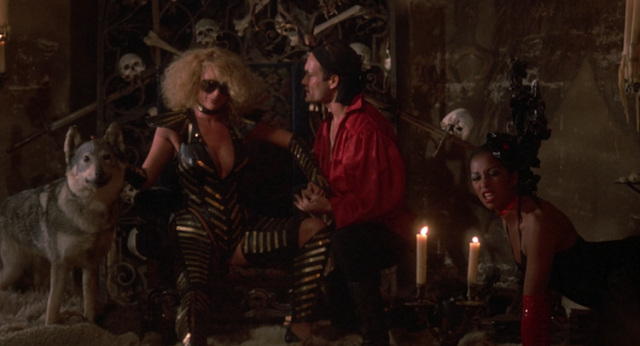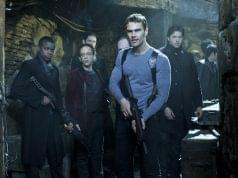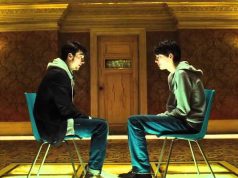
“Howling II: …Your Sister Is a Werewolf” is such an awful film that I almost feel bad making fun of it. Surely this was not a real movie that was really released in real theaters where real people were really expected to pay real money for it. Surely this was a student film, or a high-school art project, or something the residents at a home for developmentally disabled adults put together in their spare time.
But no. I have checked. It was released theatrically, and what’s more, it was an official sequel to the 1981 cult favorite “The Howling.” It was legit. When they made Part 3, they didn’t call it “Howling II: The Last One Didn’t Count” or “Howling III: Please Disregard ‘Howling II.'” This one is ON THE RECORD.
I’m so delighted with the title that there’s almost no need to talk about the movie itself. “Howling II: …Your Sister Is a Werewolf.” Yes, the ellipsis is there on the screen, as if the “your sister is a werewolf” part is an afterthought. “Hey, everybody, it’s ‘Howling II’! Oh, and also — your sister is a werewolf. But anyway!” The ellipsis is all wrong. “Your Sister Is a Werewolf” is your MAIN POINT here. Listen, fella: YOUR SISTER IS A WEREWOLF! I cannot overstate how important this is! Your sister. Is. A. WEREWOLF!
Actually, since the sister in question is dead when the movie begins, it should really be “Your Sister Was a Werewolf.” But that lacks the emotional punch.
They made about a hundred more sequels to “The Howling” after this one, and it’s too bad they didn’t retain this format in the titling. For example:
“Howling III: Your Son Is a Witch”
“Howling IV: Your Brother Is a Methodist”
“Howling V: Your Father Is Addicted to Pornography”
“Howling VI: It’s None of My Business, But I’m Pretty Sure Your Uncle Steven Is Gay”
“Howling VII: Your Mom Goes to College”
I could go on, but we have to talk about the movie. “The Howling” ended with a TV newscaster proving werewolves existed by turning into one live on the air, which resulted in her being shot dead, also live on the air. Since this all happened in front of everyone, why does her brother need to be told that she was a werewolf? Because “Howling II: …Your Sister Is a Werewolf” pretends that it happened not live on the air but mysteriously and secretly, and that the only videotape of it disappeared immediately afterward. Since this explanation makes no sense whatsoever, it is a perfect introduction to the rest of the film.
We pick things up at the woman’s funeral, where a well-dressed British man named Stefan Crosscoe (Christopher Lee) shows up to deliver a message to the woman’s grieving brother. The brother refuses to listen, but one of the deceased’s coworkers, a reporter named Jenny Templeton (Annie McEnroe), catches up with Stefan.
“What do you know about the death of Karen White?” she asks.
“I know that she is a werewolf,” Stefan replies. Then he walks away. Apparently that was all he had to say on the matter! Fade to black, roll credits.
Jenny persuades Karen’s brother, a meathead named Ben (Reb Brown), to visit Stefan to learn more. Stefan shows them the now-mysterious videotape, which he was able to get his hands on by virtue of being the character in the movie who needed to have his hands on it. He also outlines the plot of the film: Stirba is a werewolf who is about to celebrate her 10,000th birthday, and when she does, all the werewolves on earth will reveal themselves and wreak havoc and destruction. She lives in Transylvania, so they have to go there and kill her. But the regular silver bullets don’t work on mighty werewolves like her. For someone like Stirba, you need TITANIUM!
See?! Doesn’t that make things a lot more exciting? The usual werewolf-killing methods don’t work on these super-werewolves! We’re screwed now! What’ll we do?! Oh — this other thing works. And Stefan has a bunch of weapons made out of it. So … never mind. We’re still OK. Sorry to have brought it up.
Stirba has a new minion here in L.A., a sultry she-wolf named Mariana (Marsha A. Hunt), whom we’re introduced to when she picks up some trashy guys in a punk nightclub, takes them back to a warehouse, and kills them. The band playing at the club, called Babel, performs a song about werewolves, and the movie plays that same song — a generic bit of mid-80s rock — every chance it gets. The same band is even seen playing the same song in Transylvania at Stirba’s castle. If you bought the film’s soundtrack album (why would you do this?), it would probably consist of that one song repeated 12 times.
Anyway, Stefan goes with Ben and Jenny to Transylvania, where they stay at a creepy hotel in a weird little village that has a lot of dwarfs. Seriously, the incidence of dwarfism in this town should probably be investigated by the World Health Organization. Ben and Jenny check into their room, which is Room 666, which doesn’t even register with them, and they immediately have sex. It is not clear whether they were romantically involved prior to this. I tend to think not, since Jenny had earlier referred to Ben living in Montana and coming to L.A. just for his sister’s funeral. Apparently the romance of being in a satanic room surrounded by midgets in a Soviet-bloc village was too much for these two lovebirds to resist. They express their passion for one another the same way they express everything else: in a dry, bored monotone, similar to the flat voice you use when your dad forces you to tell your brother you’re sorry for hitting him.
Meanwhile, unprovoked, the movie keeps showing us scenes of Stirba’s castle. Stirba is an ancient-looking woman at first, but then she performs a sacrifice on a young woman wherein she (Stirba) sucks out the girl’s essence, which is represented by green light that passes between their mouths, as rendered by a Commodore 64 computer. Now Stirba is youthful again, and played by the amply chested B-movie legend Sybil Danning and her often-photographed breasts. Stirba, Stirba’s boobs, and Stirba’s sidekick, Vlad (Judd Omen), welcome their protege, Mariana, and the three (five?) of them turn into werewolves and cavort on a bed. It’s not sex, exactly — they just writhe around, all hairy and gross, and make howling noises. It’s probably the least erotic thing I’ve ever seen, and I’ve seen Bea Arthur’s sex tape.
Back in the weird village, the townsfolk are having a festival of some kind, probably because Eastern European villages are always having festivals in movies. Stefan knows Mariana will be there, and then they can follow her, and she’ll lead them to Stirba. How does Stefan know Mariana’s itinerary when he doesn’t know something as seemingly obvious as the location of Stirba’s giant castle? Stefan knows a lot of things he shouldn’t know, actually. It’s enough to make you suspect that he’s secretly working for the other side — except wait, that’s what would happen in a real movie. In this movie, there’s no explanation. He just happens to know a lot of stuff. Don’t question him, or he will stab you with something made of titanium.
So Mariana, sure enough, shows up at the festival, and she sees Stefan there, and he nods hello to her, which I probably would not do if I were trying to remain stealthy. I’m just sayin’. Then, when Mariana leaves, having had her fill of corn dogs and cotton candy, Stefan doesn’t follow her, even though following her was the whole plan. Instead, Ben and one of the dwarfs follow her, and the dwarf gives Ben special earplugs that he has to wear as they approach Stirba’s domain, and then the dwarf’s own earplugs fall out. “I lost my earplugs!” he cries, in what is surely the most emotionally charged moment in the entire film. At the castle, Stirba starts chanting all crazy-like, and the sound of it carries for miles, and the dwarf can’t find his earplugs, and then his eyes pop out of his skull like squished bugs. Ta-da!
At the film’s 60-minute mark, Jenny gets captured by Stirba’s minions. The rest of the film — a full half-hour — is spent on Ben and Stefan barging into the castle, titanium weapons a-blazin’, to rescue her and kill Stirba. At one point a priest gets attacked by a bat-like creature, though I don’t know how this relates to anything else. Suffice it to say that the Jenny-rescuing process is dragged out for much longer than it ought to be, especially given the incompetent manner in which everything is shot and edited. Any shot involving a werewolf is filmed either in tight close-up or from very far away, preventing us from getting a good look at it. This is obviously because the makeup and costumes are hilarious, and the director, a French guy named Philippe Mora, wants to keep that a secret for as long as possible.
Mora is also fond of inserting random shots of unrelated things into the action. Ben and Jenny will be walking along a cobblestone street in the creepy village when all of a sudden there’s a shot of a gargoyle. Or we’ll see Stirba writhing around nudely in her castle, and boom, there’s a random image of Mariana back at the warehouse in L.A. It’s as if Mora slept through a film class once, woke up long enough to hear someone mention Soviet montage theory, made a note to Google it later, then went back to sleep. The fact that Google did not exist at this time does not detract from the soundness of my theory.
Oh, we find out at the end that Stefan is Stirba’s brother, but I don’t find that interesting. He kills her anyway. Is Stefan a werewolf, too? I don’t think so. The movie doesn’t say. The movie doesn’t say a lot of things, and a lot of the things it does say are idiotic. My sister’s a werewolf? SO IS YOURS, STEFAN! So is yours.
P.S. In the U.K., this film was called Howling II: Stirba — Werewolf Bitch. I think you’ll agree that this is inferior, and unfair to Stirba, who is actually fairly pleasant for a 10,000-year-old woman.
— Film.com





